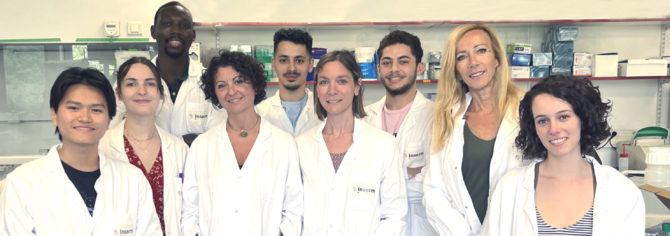 Team leader : France Pietri-Rouxel
Team leader : France Pietri-Rouxel
The team’s research trajectory is driven by the desire to conduct studies aimed at understanding the mechanisms underlying the maintenance of muscle mass in diseased and aging muscles. This axis is in constant interaction with the development of the optimization of DMD therapeutic strategies and extends to other neuromuscular diseases.
Deciphering the role of the CaVβ1/GDF5 pathway in counteracting loss of muscle mass and function
CaVβ1, encoded by Cacnb1 gene, exists as several transcript variants in skeletal muscle. Our recent work demonstrates CaVβ1D as the constitutive adult isoform, localized with CaVα1 at the triad. On the other hand, we show that CaVβ1E and CaVβ1A are expressed at late embryogenesis and peri-natal stages. In adult muscle, the re-expression of these embryonic CaVβ1E and/or CaVβ1A isoform(s) plays a crucial role in muscle mass homeostasis when electrical activity is impaired by preventing loss of muscle mass. We showed that both the embryonic CaVβ1E/CaVβ1A and the adult constitutive isoform CaVβ1D expression derives from the activation of two distinct promoters and that the switch induced by denervation can be regulated through the restoration of an embryonic epigenetic program. These results bring insights on the mechanism behind the induction of embryonic CaVβ1 isoform expressions in adult skeletal muscle after impaired electrical activity and rise questions regarding the role of CaVβ1 isoforms both in embryonic and adult skeletal muscles.
Pre-clinical study of GDF5-based treatment against sarcopenia
One of the major concerns of the public health system is represented by the growing number of people suffering of sarcopenia, a progressive loss of skeletal muscle force, quality and mass during aging which results in increased debility and death. Despite several studies carried out on the various aspects of this disease therapeutic approaches counteracting age-related muscle degradation are only limited to caloric restriction and exercise with restricted patient compliance. For these raisons, the identification of novel drug candidates to counteract age-related muscle wasting is still a challenge. In this scenario, GDF5 can be a player candidate of big interest. GDF5 belongs the Bone Morphogenetic Protein (BMP) family. Our previous work demonstrated that boosting GDF5 signaling is able to prevent age-related muscle wasting. We largely extended the analyses of the effects of GDF5-based treatment on skeletal muscle during aging. Our results show that local GDF5 OE in mice, at the beginning of age-related muscle decline, is able to increase muscle mass and function, ameliorating neuro-muscular connectivity and preventing NMJ degradation. We demonstrated that GDF5 OE exerts a “rejuvenating” activity on the whole transcript in aged mouse muscle. Importantly, we establish a potential therapeutic protocol, by systemic recombinant GDF5 (rGDF5) administration starting in early phase of aging, which recapitulates in the long term the benefits observed upon local GDF5 OE and which can be translated to humans. Based on this proof of concept, we provided an optimized synthetic human-GDF5 to be used in humans for clinical trials and, eventually, therapy. Today, we are determining the optimal dose to be used for future assays and studies to determine the best administration route are also ongoing, using the optimized GDF5 product.
Understanding fundamental mechanisms underlying the hyperplastic effect of GDF5 in DMD muscles
In DMD the lack of the protein dystrophin leads to the damage of the integrity of muscle fibers accompanied by cycles of degeneration/regeneration. Initially, regeneration is supported by the proliferation and differentiation of satellite cells (MuSCs). However, their regenerative potential is gradually depleted resulting in muscle dysfunction. Nevertheless, other resident muscle cells (MRCs) have been shown to participate in muscle regeneration. Despite evidence that GDF5 is a positive modulator of muscle mass homeostasis and a potential regulator of muscle repair, its potential applications to preserve muscle quality in disease such as DMD has not been explored. Our preliminary results revealed that GDF5 treatment promotes a hyperplastic effect in DMD muscle through modulation of MRCs. In order to understand dystrophic muscle response to GDF5 treatment and pinpoint the cellular players mediating its beneficial effect we will take advantage of a combine snRNAseq – Spatial Transcriptomics. This strategy will enable us to identify i) which cell populations are responding to GFD5 and ii) how the cellular crosstalk within the regenerating niche is modulated by the treatment).
Combined treatment GDF5 and AAV-microdystrophin
Our previous study carried out to optimize AAV gene therapy in dystrophic muscle showed the advantages of a combined treatment. Considering the hyperplastic effect of GDF5 in the DMD muscle, we overexpressed GDF5 using an AAV serotype 9 to induce the formation of new fibers, then we injected a therapeutic AAV- serotype 10 carrying micro-Dystrophin (µDys) transgene to treat fibers including newly formed ones. Our preliminary data showed increase of small fiber number, modulation of regeneration and importanly, increase of the number of small µDys positive fibers in condition of dual treatment AAV-GDF5/AAV-µDys compared to the AAV-µDys alone, this revealing a synergic effect of GDF5 overexpression and the µDys gene therapy. We we next will evaluate administration of synthetic protein GDF5 (sGDF5) in combination or not with AAV-µDys in a severe DMD preclinical model, the rat R-DMDdel52 that accurately mimics disease phenotype and evolution seen in human patients, with progressive muscle loss and cardiac dysfunction, early lethality and most of the clinical and histological signs of DMD.
Unraveling the novel role of GDF5 signaling in Amyotrophic Lateral Sclerosis (ALS)
Muscle denervation is a common hallmark of several neuromuscular diseases and accounts for skeletal muscle atrophy and dysfunction associated to their pathophysiology. Importantly, the activation of GDF5/SMAD1/5 pathway was described to be essential in the correct re-innervation after nerve damage and, also, beneficial for early and late motor neuron dysfunction in an ALS model. Notably, we observed that GDF5 protein expression decreased at the onset of symptomatic phase in the well characterized SOD1G93A ALS mouse model, suggesting that this dysregulation could exacerbate the disease progression by disabling efficient nerve regeneration. Starting from these evidences, we hypothesized that GDF5-based treatments could preserve ALS innervation and muscle mass and function and have a beneficial impact on the pathophysiology of the disease. Our preliminary data, obtained in collaboration with 3 teams, showed that GDF5 overexpression delays disease progression, by limiting body weight loss, muscle atrophy and strength drop. Overall, our results strongly indicate that GDF5-based treatment in ALS protected against denervation and could be beneficial on its pathophysiology in a whole. Our goal today is to unravel the mechanisms behind the beneficial effects of GDF5 in ALS and to design innovative protocols based either on GDF5 supplementation or a combination of GDF5 and gene-therapy.

Team members
PIETRI-ROUXEL France, Team leader
FALCONE Sestina, Researcher
GENTIL Christel, Engineer
TRAORE Massiré, Engineer
FAIL Aurélie, Engineer
BOURGUIBA Aly, PhD student
VERGNOL Amélie, PhD student
GELIN Maxime, PhD student
Contact
Last publications
- Traoré Massiré$, Noviello Chiara$, Vergnol Amélie, Gentil Christel, Halliez Marius, Saillard Lucile, Gelin Maxime, Forand Anne, Lemaitre Mégane, Guesmia Zoheir, Cadot Bruno, Caldas Eriky, Marty Benjamin, Mougenot Nathalie, Messéant Julien, Strochlic Laure, Sadoine Jeremy, Slimani Lofti, Jolly Ariane, De la Grange Pierre, Hogrel Jean-Yves, Pietri-Rouxel France$, Falcone Sestina$, GDF5 as a rejuvenating treatment for age-related neuromuscular failure, Brain, 2024 Apr 8:awae107. doi: 10.1093/brain/awae107. Online ahead of print. Affiliations expand, PMID: 38584513. $equal contribution
- Pietri-Rouxel F, Falcone S, Traoré M. GDF5: a therapeutic candidate for combating sarcopenia. Med Sci (Paris). 2023 Nov;39 Hors série n° 1:47-53. doi: 10.1051/medsci/2023143. Epub 2023 Nov 17. PMID: 37975770 French.
- Amélie Vergnol, Massiré Traoré, France Pietri-Rouxel* and Sestina Falcone* New Insights in CaVβ Subunits: Role in the Regulation of Gene Expression and Cellular Homeostasis Front. Cell Dev. Biol., 06 April 2022 | https://doi.org/10.3389/fcell.2022.880441
- Noviello C, Kobon K, Randrianarison-Huetz V, Maire P, Pietri-Rouxel F, Falcone S, Sotiropoulos A. RhoA Is a Crucial Regulator of Myoblast Fusion. CELLS. 2023;12(23). doi:10.3390/cells12232673
- Morin A, Stantzou A, Petrova O, Hildyard J, Tensorer T, Matouk M, Petkova M, Richard I, Manoliu T, Goyenvalle A, Falcone S, Schuelke M, Laplace-Builhé C, Piercy R, Garcia L, Amthor H. Dystrophin myonuclear domain restoration governs treatment efficacy in dystrophic muscle. PROCEEDINGS OF THE NATIONAL ACADEMY OF SCIENCES OF THE UNITED STATES OF AMERICA. 2023;120(2). doi:10.1073/pnas.2206324120
- de Zélicourt A, Fayssoil A, Dakouane-Giudicelli M, De Jesus I, Karoui A, Zarrouki F, Lefebvre F, Mansart A, Launay JM, Piquereau J, Tarragó MG, Bonay M, Forand A, Moog S, Piétri-Rouxel F, Brisebard E, Chini CCS, Kashyap S, Fogarty MJ, Sieck GC, Mericskay M, Chini EN, Gomez AM, Cancela JM, de la Porte S. CD38-NADase is a new major contributor to Duchenne muscular dystrophic phenotype. EMBO Mol Med. 2022 May 9;14(5):e12860. doi: 10.15252/emmm.202012860. Epub 2022 Mar 17. PMID: 35298089
- Vergnol A, Traoré M, Pietri-Rouxel F, Falcone S. New Insights in CaVβ Subunits: Role in the Regulation of Gene Expression and Cellular Homeostasis. Front Cell Dev Biol. 2022 Apr 6;10:880441. doi: 10.3389/fcell.2022.880441. eCollection 2022. PMID: 35465309
- Boulinguiez A, Duhem C, Mayeuf-Louchart A, Pourcet B, Sebti Y, Kondratska K, Montel V, Delhaye S, Thorel Q, Beauchamp J, Hebras A, Gimenez M, Couvelaere M, Zecchin M, Ferri L, Prevarskaya N, Forand A, Gentil C, Ohana J, Piétri-Rouxel F, Bastide B, Staels B, Duez H, Lancel S. NR1D1 controls skeletal muscle calcium homeostasis through myoregulin repression. JCI Insight. 2022 Sep 8;7(17):e153584. doi: 10.1172/jci.insight.153584. PMID: 35917173
- Mollard A, Peccate C, Forand A, Chassagne J, Julien L, Meunier P, Guesmia Z, Marais T, Bitoun M, Piétri-Rouxel F, Benkhelifa-Ziyyat S, Lorain S. Muscle regeneration affects Adeno Associated Virus 1 mediated transgene transcription. Sci Rep. 2022 Jun 11;12(1):9674. doi: 10.1038/s41598-022-13405-9. PMID: 35690627
- Taglietti V, Kefi K, Bronisz-Budzyńska I, Mirciloglu B, Rodrigues M, Cardone N, Coulpier F, Periou B, Gentil C, Goddard M, Authier FJ, Pietri-Rouxel F, Malfatti E, Lafuste P, Tiret L, Relaix F. Duchenne muscular dystrophy trajectory in R-DMDdel52 preclinical rat model identifies COMP as biomarker of fibrosis. Acta Neuropathol Commun. 2022 Apr 25;10(1):60. doi: 10.1186/s40478-022-01355-2. PMID: 35468843
Patents
- Combined therapy for muscular diseases/A1/WO2021089736)
- EP24305219 PEGYLATED GDF5 PROTEIN Pietri-Rouxel F, Falcone S, Traoré M. and Noviello C.
- WO2016198676A1 publication Critical patent/WO2016198676A1 COMBINED THERAPY FOR DUCHENNE MUSCULAR DYSTROPHY Lorain et al.
- EP18 184861.5 and 19 152677.1 COMPOSITIONS FOR THE TREATMENT OF SARCOPENIA OR DISUSE ATROPHY Piétri-Rouxel & Falcone
- EP19207561.2.COMBINED THERAPY FOR MUSCULAR DISEASES Piétri-Rouxel & Falcone

